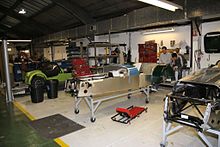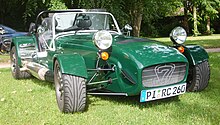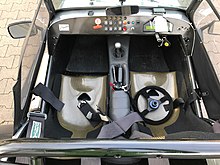Caterham Cars
| Caterham Cars Ltd.
|
|
|---|---|
| legal form | Private Limited Company |
| founding | 1974 |
| Seat | Dartford |
| Website | www.caterhamcars.com |
Caterham Cars , Seven Cars until 1989 , is an automobile manufacturer in England specializing in sports cars .
The company was founded by Graham Nearn, who was a Caterham based dealer for Lotus Cars . After Lotus had finished manufacturing the Lotus Seven in 1972 due to a lack of liquidity , Nearn bought the rights to the construction in 1973 and then resumed production.
Models
Nearn did not continue to produce the last version of the Lotus Seven, the Series 4 with a larger body and controversial design, but with a few modifications the previous Series 3.
Over the years, Caterham launched a large number of variants of the Seven, which were powered by different engines: from the tried and tested Ford four-cylinder Kent series with 1300 or 1600 cm³ to the Lotus Twin-Cam double camshaft engine, Vauxhall / Opel machines to the motorcycle engine of the Honda Blackbird. Since the mid-1990s, Rover engines of the K series with 1400, 1600 or 1800 cm³ were used, including the VVC engine (with variable valve timing) from the MGF. In January 2007, the smaller Rover engines were replaced by the 1.6l Zetec S engine from Ford, which is offered in different versions from 85 to 110 kW (115-150 hp).
Technically, the Seven has undergone a number of changes over time. From 1985, instead of the rigid rear axle, a De-Dion axle was also available, which improved handling. The frame was stiffened several times and a six-speed gearbox developed by Caterham has also been available since 1995. In 2001, Caterham revised the concept and developed the Superlight R500. This is still based on the 1.8-liter engine of the Rover K-Series, but has been increased by Minister Racing Engines to around 230 bhp (172 kW) at 8600 rpm. The curb weight of the vehicle is 460 kg. It accelerates from 0 to 100 miles per hour in 8.2 (or 8.8) seconds. Due to the registered stationary noise of 106 dB (A), single throttle valve system and a removable steering wheel, approval in Germany was initially only possible if the vehicle was first registered in the United Kingdom . Therefore, all registered vehicles are left-hand drive. The R500 was originally available as a kit, later it was only sold as a finished vehicle. The further development R500 Evo was brought onto the market in 2004 and developed 268 hp (200 kW) with an enlarged displacement of 1,998 cm 3 . With a retail price of £ 42,000, the R500 EVO sold poorly - only three examples are widely believed to have sold. However, some records were set with him, some of which still exist today. The R500 Evo remained the fastest production car tested by EVO magazine at the Bedford Autodrome West Circuit until the end of 2006.
In 2005, under new management, Caterham introduced the CSR, the most comprehensive model change since the Lotus Seven Series 4. The newly designed CSR frame is longer, wider and significantly stiffer. It is no longer soldered by hand, but welded by robots. The CSR has all-round independent suspension and, in the Formula 1 style, internal springs and dampers at the front. A 2.3-liter Ford Duratec with 149 or 194 kW (200/260 bhp), which has been revised by Cosworth , is available as an engine . This is the most powerful engine to date in a production Caterham.
The Seven is a so-called kit car , a kit car that you can build yourself. Kit Cars were invented in England in the 1960s to avoid the then very high new car tax.
Even if this high new car tax no longer applies, Caterham still offers its cars for self-build. Alternatively, the vehicles can be assembled at the Caterham factory for an extra charge. In contrast to the classic kit car, in which, apart from the frame, most of the components were taken from mass-produced vehicles (often also as used parts), today almost all of the Seven's components are specially manufactured for this vehicle or at least have been extensively modified for use. As a result, the cost savings that can be achieved by self-construction have in fact continued to decline and are currently (as of May 2006) around EUR 4000, which corresponds to around 7 to 15% depending on the model.
The attempt to offer an independent second model series with the Caterham 21 was not a great success; from 1995 to 1999 only 49 copies of this moderate roadster were built.
In January 2011, Caterham Cars surprised with the SP / 300R, a modern new design of a racing car in collaboration with Lola Cars .
In April 2011, Tony Fernandes and his business partner in Formula 1 , in the legal dispute with Lotus Cars over the name Team Lotus , bought the company Caterham Cars.
Technical data: Caterham Seven
| Seven 165 | Seven 275 | Seven 355 | Seven 485 | Seven R 500 | Seven 620 R | |
|---|---|---|---|---|---|---|
| Engine characteristics | ||||||
| Engine type | R3 petrol engine | R4 petrol engine | ||||
| Engine charging | turbocharger | - | Supercharged (compressor) | |||
| Displacement | 660 cc | 1596 cc | 1999 cc | |||
| Max. Power at min −1 | 59 kW (80 PS) / 7000 | 100 kW (136 PS) / 6800 | 129 kW (175 PS) / 7300 | 177 kW (241 PS) / 8500 | 197 kW (268 PS) / 7200 | 228 kW (310 hp) / 7700 |
| Max. Torque in min -1 | 145 Nm / 3400 | 165 Nm / 4100 | 194 Nm / 6100 | 206 Nm / 6300 | 239 Nm / 7200 | 297 Nm / 7350 |
| Power transmission | ||||||
| drive | Rear wheel drive | |||||
| Dimensions | ||||||
| Length Width Height | 3380 mm / 1575 mm / 1090 mm | |||||
| wheelbase | 2225 mm | |||||
| Readings | ||||||
| Top speed | 160 km / h | 196 km / h | 225 km / h | 241 | 250 km / h | |
| Acceleration, 0-100 km / h | 7.5 s | 5.0 s | 4.8 s | 3.4 s | 2.88 s | 2.7 s |
| Empty weight | 490 kg | 540 kg | 560 kg | 525 kg | 460 kg | 545 kg |
| Fuel consumption over 100 km (combined) | 4.9 l super | 6.3 l super | 9.0 l super | 9.8 l super | 9.3 | 7.7 l super |
| CO 2 emissions (combined) | 114 g / km | 137 g / km | 182 g / km | 194 g / km | 188 g / km | 179 g / km |
literature
- Chris Rees : The Magnificent Seven. Haynes Publishing, Sparkford 2002. ISBN 1-85960-848-5 . (English, German edition published in 2007: ISBN 3-89880-650-2 )
Web links
Individual evidence
- ^ Richard S. Chang: Graham Nearn, Founder of Caterham Cars, Is Dead . The New York Times . October 28, 2009. Retrieved October 13, 2013.
- ↑ a b Evo magazine, issue 100. Dennis Publishing, January 2007
- ↑ Caterham Announces SP / 300.R racer . British Broadcasting Corporation . January 14, 2011. Retrieved October 13, 2013.
- ↑ Team Lotus buys Caterham as dispute over iconic name takes new twist . The Daily Telegraph . April 27, 2011. Retrieved October 13, 2013.






